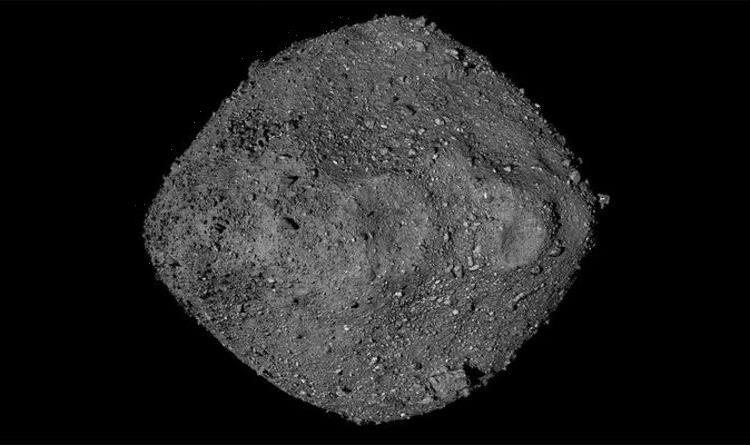Asteroid Bennu: NASA sheds light on near-earth object
We use your sign-up to provide content in ways you’ve consented to and to improve our understanding of you. This may include adverts from us and 3rd parties based on our understanding. You can unsubscribe at any time. More info
Bennu has been at the heart of NASA’s OSIRIS-REx mission, which has been exploring the asteroid and collecting surface samples since 2018. The mission has also allowed NASA’s scientists to learn more about Bennu’s uncertain orbit as it is expected to come “close” to Earth in the next 200 years. Because of its size and trajectory, NASA has branded Bennu a “potentially hazardous asteroid” or PHA.
Bennu is estimated to measure about 1,600ft (490m) at its equator, meaning it is bigger than the Statue of Liberty and Eiffel Tower combined.
And according to a new study published by NASA’s scientists, the odds of Bennu crashing into Earth are higher than previously thought.
Luckily for us, the odds of impact are still so slim you shouldn’t lose any sleep over them.
Davide Farnocchia at NASA’s Jet Propulsion Laboratory said Wednesday: “We shouldn’t be worried about it too much.”


The odds of Bennu striking the planet have risen from about 1/2,700 to 1/1,750 in the next 200 years.
In other words, that is an average 0.057 percent chance of impact by the year 2300.
Asteroids of various shapes and sizes make frequent passes of the Earth which scientists have dubbed “close approaches”.
But they are only close in astronomical terms as according to NASA, these can be “millions or even tens of millions of kilometres” away.
Using NASA’s Deep Space Network and computer simulations, scientists analysing Bennu’s orbit have pinpointed September 24, 2182, as one of the most important dates in terms of impact probability.
NASA: OSIRIS-REx collects sample from asteroid Bennu’s surface
But even on this day the chances of Bennu hitting are a low 0.037 percent.
Bennu will also swing by our planet on September 25, 2135, allowing scientists to study the effects of Earth’s gravity on its orbit.
In particular, there is a chance Bennu will pass through a “gravitational keyhole” that could set it on a future collision path with the planet.
Gravitational keyholes are regions in space that can shift an asteroid’s trajectory in a new, uncertain direction.
Kelly Fast, programme manager for the Near-Earth Object Observations Program at NASA HQ, said: “NASA’s Planetary Defense mission is to find and monitor asteroids and comets that can come near Earth and may pose a hazard to our planet.


“We carry out this endeavour through continuing astronomical surveys that collect data to discover previously unknown objects and refine our orbital models for them.
“The OSIRIS-REx mission has provided an extraordinary opportunity to refine and test these models, helping us better predict where Bennu will be when it makes its close approach to Earth more than a century from now.”
Although the odds of Bennu striking the planet have risen, scientists now have a much clearer picture of the asteroid’s orbit – and that is very good news for us.
Dr Farnocchia told reporters on Wednesday: “So I think that overall, the situation has improved.”
NASA’s OSIRIS-REx spacecraft left Bennu earlier this year and is now headed back to Earth.
The probe is expected to return by 2023 when it will send a return capsule with parachutes into Earth’s atmosphere.
OSIRIS-REx is carrying surface samples hoovered up from Bennu in late 2020.
Scientists are keen to learn through the space rocks about the earliest days of the solar system.
Source: Read Full Article
